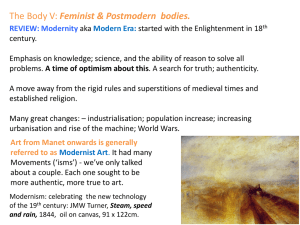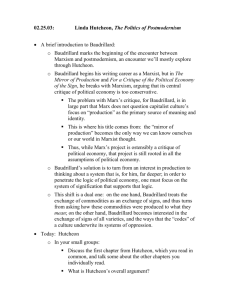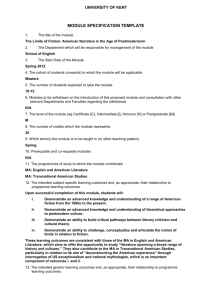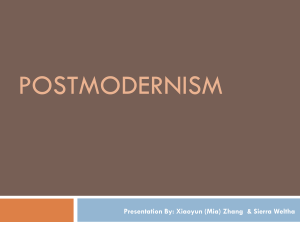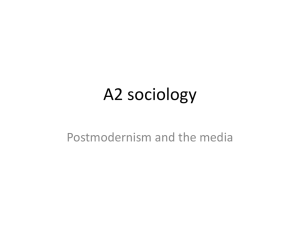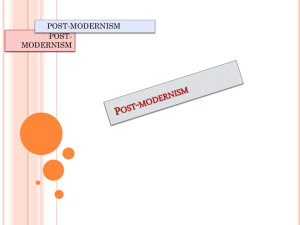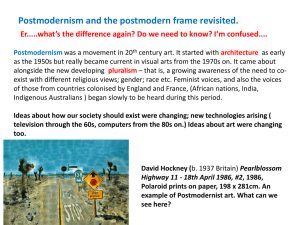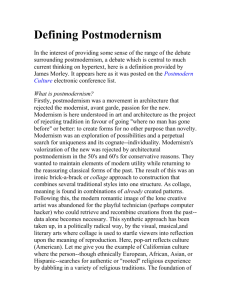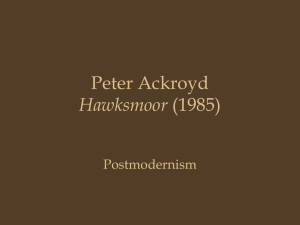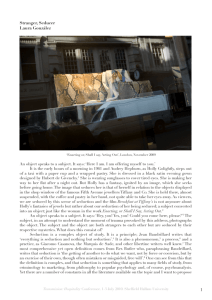Curly, Larry & PoMo
advertisement
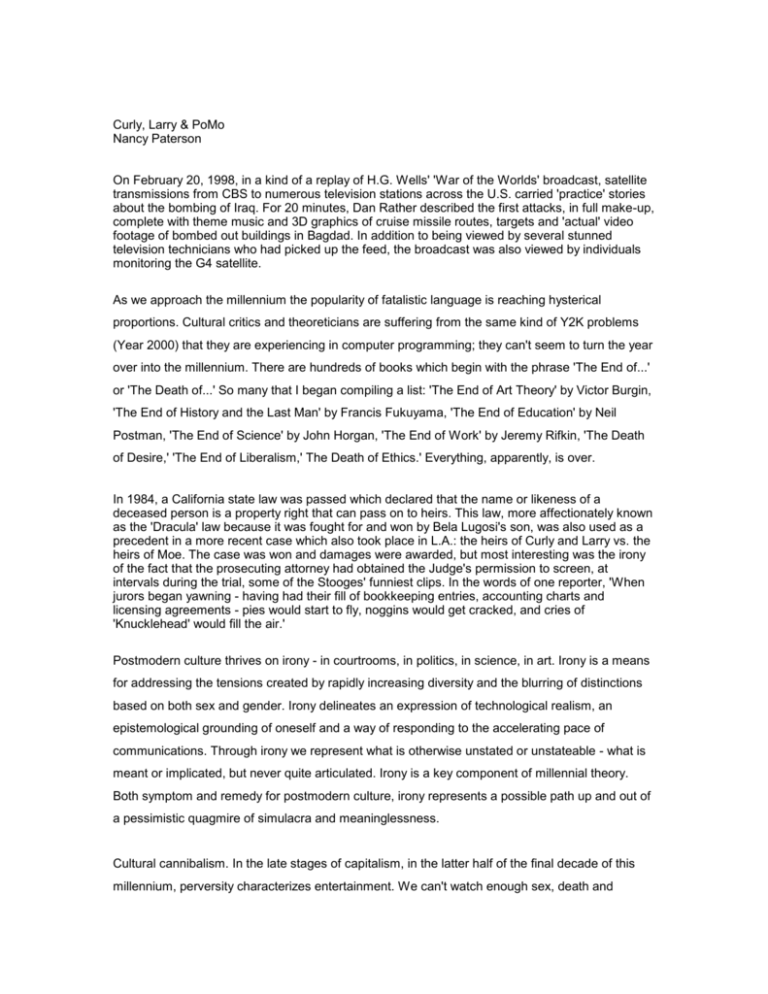
Curly, Larry & PoMo Nancy Paterson On February 20, 1998, in a kind of a replay of H.G. Wells' 'War of the Worlds' broadcast, satellite transmissions from CBS to numerous television stations across the U.S. carried 'practice' stories about the bombing of Iraq. For 20 minutes, Dan Rather described the first attacks, in full make-up, complete with theme music and 3D graphics of cruise missile routes, targets and 'actual' video footage of bombed out buildings in Bagdad. In addition to being viewed by several stunned television technicians who had picked up the feed, the broadcast was also viewed by individuals monitoring the G4 satellite. As we approach the millennium the popularity of fatalistic language is reaching hysterical proportions. Cultural critics and theoreticians are suffering from the same kind of Y2K problems (Year 2000) that they are experiencing in computer programming; they can't seem to turn the year over into the millennium. There are hundreds of books which begin with the phrase 'The End of...' or 'The Death of...' So many that I began compiling a list: 'The End of Art Theory' by Victor Burgin, 'The End of History and the Last Man' by Francis Fukuyama, 'The End of Education' by Neil Postman, 'The End of Science' by John Horgan, 'The End of Work' by Jeremy Rifkin, 'The Death of Desire,' 'The End of Liberalism,' The Death of Ethics.' Everything, apparently, is over. In 1984, a California state law was passed which declared that the name or likeness of a deceased person is a property right that can pass on to heirs. This law, more affectionately known as the 'Dracula' law because it was fought for and won by Bela Lugosi's son, was also used as a precedent in a more recent case which also took place in L.A.: the heirs of Curly and Larry vs. the heirs of Moe. The case was won and damages were awarded, but most interesting was the irony of the fact that the prosecuting attorney had obtained the Judge's permission to screen, at intervals during the trial, some of the Stooges' funniest clips. In the words of one reporter, 'When jurors began yawning - having had their fill of bookkeeping entries, accounting charts and licensing agreements - pies would start to fly, noggins would get cracked, and cries of 'Knucklehead' would fill the air.' Postmodern culture thrives on irony - in courtrooms, in politics, in science, in art. Irony is a means for addressing the tensions created by rapidly increasing diversity and the blurring of distinctions based on both sex and gender. Irony delineates an expression of technological realism, an epistemological grounding of oneself and a way of responding to the accelerating pace of communications. Through irony we represent what is otherwise unstated or unstateable - what is meant or implicated, but never quite articulated. Irony is a key component of millennial theory. Both symptom and remedy for postmodern culture, irony represents a possible path up and out of a pessimistic quagmire of simulacra and meaninglessness. Cultural cannibalism. In the late stages of capitalism, in the latter half of the final decade of this millennium, perversity characterizes entertainment. We can't watch enough sex, death and automobile accidents. And if the actors are having sex with dead people, or during car crashes or with dead people during car crashes - even better. In the fall-out shelters of our nuclear families we have become so estranged from authentic experience that reality has ceased to exist. In our media-saturated world, vicarious experiences are the standard against which 'reality' is judged. Picking up the telephone, as you know, is no longer 'the next best thing to being there.' It is being there. As much consciousness is manifested there as through physical presence. We are moving into a period which may be described as post-postmodern. What is that? Or, as Northrop Frye used to say, 'Where is here?' This period may be best described as Millennialism. Both democracy and totalitarianism recognize individualism and public opinion as sources of power. Both are strategies for coping in a relativistic world. Fascism and democracy become interchangeable in this convergence of technological control. The control of information is the real discourse of power. A new ideology emerges in which terrorism and manipulation are focused more obliquely on areas such as medical research, education, advertising and telecommunications. Creativity, the processing and distribution of ideas, are also subject to the effects of convergence, which is happening in society on more than the level of communications technology. Convergence is happening on a deeper philosophical level as well. As power shifts from the political-economic realm to the technological-economic world, the real power no longer lies with elected or appointed heads of states, but is in the hands of those who control and perpetuate an economy based on electronic technologies. Microsoft world domination is one tenable example. The encounter between Bill Gates and the pie-wielding anarchist group L'Entarteur in Brussels in January 1998 might best be described as 'just deserts.' It is time to move beyond postmodernism, which has become a comfortable philosophy for privileged, white, and mostly male theorists - a sort of sociological/aesthetic 'laissez faire.' Misogyny has found a willing host in postmodern theory. Women's link to the physical world (ie. nature) is emphasized and this entitles postmodern theorists to dismiss women as antiintellectual. Women have also suffered from the backlash - feminist philosophers who attempt to describe themselves as postmodernists are dismissed as being in denial of their physical nature (sex). Only men, apparently, can have it both ways and be good postmodernists. Postmodernism has outlived its usefulness, and pragmatic feminism has been one near-casualty. In our recognition and analysis of the association which has been manufactured between discourse and power it is essential, as feminists such as Irigaray, Cixous and Kristeva have pointed out, that we understand language as a patriarchal construction. We do not all bestow significance on what we name and recognize, this is a privilege reserved for a select elite who attempt to define: politics, science, art, etc. The effectiveness of irony relies on what is not spoken and it is the irony inherent in postmodernism which may halt this treacherous slide across the thin surface of our collective unconscious and compulsion for 'naming.' Words have the power you give them; language cannot explain everything. We must also be wary of postmodernism's obsession with the 'image' and the confusion of artistic technique with creation. In fact, creativity supersedes technique, and there is nothing to be gained, but much to be lost in proclaiming the 'end' or 'death' of art. Within millennial theory, cyberfeminism must be defined from the perspective of North American pragmatism - not a utopian vision. I am looking for a feminism that works - right here, right now. A feminism which is inclusive of all cultures, of all genders. Anyone can play. Cyberfeminism is a starting point. As control of information has become the new measure of power, de-industrialization of first world cultures and economies are throwing the democratic 'foundational' myths of progress and growth into a tailspin. The encouragement and protection of creative work will become increasingly problematic. And there is the potential for the feminist movement to outgrow its emergence as a North American phenomenon, and take a leading role on the world stage - by addressing issues such as diversity, the ubiquity of electronic technologies and transgender politics. How does cyberfeminism fit into contemporary culture? What is it about de-industrialization and new media that has given rise to cyberfeminism? The answers I am able to propose address the persistence and future of art - electronic media art - as we approach the millennium. The transition from postmodernism to millennialism can be examined through the fields of evolutionary biology, philosophy and feminism. The processes of communication, simulation and sex are addressed through Richard Dawkins, Jean Baudrillard and Camille Paglia - Curly, Larry & PoMo. Richard Dawkins, one of the leading thinkers in modern evolutionary biology, introduced the concept of the 'meme' over 20 years ago in order to point out how Darwinism and natural selection are not necessarily tied to genes, but can work wherever self-replicating code exists. The meme, therefore, was intended to explore the similarities between cultural and genetic evolution - in particular, how ideas, trends and other cultural representations develop and are spread through imitation, by word-of-mouth, and through mass media. The survival of the fittest ideas, transmitted through postmodern culture like disease - is a metaphor which tells us nothing new about biology, intelligence or communication - but a great deal about postmodern culture. Millennial Anxiety, the Jerusalem Syndrome, Intellectual Copyright, the persistence of Charismatic and Apocalyptic Religions, the Human Genome Project, the obligations of the Paparazzi - these describe the state of ethics in postmodern culture - wholesale desperation and chaos. In North America, Instrumentalist theory has replaced phenomenological thinking. The cycle of 'production - distribution - consumption' no longer merely describes our economic/political system, but is emerging as our new philosophy and psychology. 'Reductionist' accounts of human behavior diminish individual responsibility in acts of horrific violence by relying on a variety of genetic, chemical or nature-and-nurture explanations. Prozac. Twinkies. Multiple intelligences. The memes are flowing thick and fast. Significantly, Dawkins' theory of 'memes' does not deal adequately with creativity - how ideas originate, how they are developed and improved through processes which are dynamic and unquantifiable. He does not deal at all with the dissemination of ideas through means of complex pattern recognition - intuition, insight and telepathy. If Artificial Intelligence research ever breaks this particular code, there will be no looking back. However, Dawkins is a biologist. He is treading in dangerous, murky waters when his theories attempt to deal with creativity and the communication of ideas. The patriarchal basis of postmodernism - whether 'reality' or simulation - remains virtually unchallenged. It is, in fact reinforced by Baudrillard in his theory of seduction which is proposed as a way of undermining systems and meaning, and promoting the process and role of simulation. Baudrillard envisions the feminine as an uncertainty principle, and seduction as its main strength. Manipulation, sedition - a woman's charms. In Baudrillard's theory of seduction, he proposes the deliberate and provocative manipulation of signs as an alternative to production and communicative interaction. In essentializing the differences between the 'masculine' and the 'feminine,' Baudrillard's debt to Freud emerges. He is clearly not interested in any specific issues of women's social condition or feminist theory. In fact, in a paper titled 'Plastic Surgery for the Other' he dismisses feminism as 'an example of hystericization of the masculine by women, a hysterical projection of their masculinity which follows exactly the hysterical projection by men of their femininity in the mythic image of a woman.' So, women project their masculinity in order to try to define themselves, men project their femininity in order to try to define - women. Presumably it is not necessary for men to try to define themselves - as there is one sexuality, one libido for Baudrillard as for Freud, and it is masculine. There are women who agree with Baudrillard's attacks on feminism - and some of these women, by some perverse logic of appropriation, describe themselves as feminists. Camille Paglia, for example, is quoted as saying with apparent amazement 'They're calling anti-woman a woman who has spent hundreds of hours with her head between other women's legs. And who loves it!' Imagine that. In polite circles Paglia's position is described as a naturalistic celebration of sexuality. However, in her obsession with figures such as Madonna, we see the ultimate commodification of gender. Victimization as a play for power. Very close, in fact, to Baudrillard's description of seduction. And quite in keeping with Richard Dawkins' description of how ideas become embedded in the cultural fabric. Paglia describes the development of the position which she supports as originating in the earliest mother-cults, through the book of Genesis, to Freud with more to come, presumably, in her sequel to Sexual Personae. Paglia's star may very well be fading, and she has not achieved the same international notoriety which she has enjoyed in North America. However, she is representative of the extreme interpretations to which postmodernism lends itself and the possible perversion of this philosophy in the service of an essentialism which attempts and often succeeds in describing itself as feminist. In postmodern culture, according to Baudrillard, we must doubt more than the value of our subjective experience but also the very existence of our subjectivity. The 'subject' (we are told) has disappeared into a whirling void of spectacular and philosophical dimensions. Feminists are dismissed, told to pay homage to technological determinism, seduction, and the inevitability of the feminine ideal. Individual experience is meaningless. Our power, we are told, is not to be had through any mastery of technology - but through an acceptance of our ability to exploit (ourselves) and to manipulate (men). Repeating a predictable analogy between sexual physiology and culture, Paglia explains that men dominate art, science and politics because of their ability to 'project.' Women are valued (and doomed) solely through their relationship with nature. Freud asserted that women lack even the capacity for pleasurable spectatorship because they lack the masculine ability to fetishize and thereby separate themselves from an object. And now that the 'object' has been replaced by a simulation, Baudrillard would say we are twice removed. Cyberfeminism recognizes that it is precisely due to our culturally enforced distance from technology, that women are in a position to explore the three tenets of feminism after postmodernism, through artistic practice: diversity, the ubiquity of technology and transgender politics. If we lack the capacity for spectatorship, we have the capacity for action. If we lack the masculine 'ability' to fetishize technology, then we are able to understand that culture is not what you live in, but what you live through. The individualization of feminist politics by postmodernists has demobilized women. Theorists such as Baudrillard reject Europe as a model for postmodernism because of a continental preoccupation with difference. Disregard for difference is what he sees as America's strength. However, postmodern feminism has been largely defined by European feminists and encourages the idea of difference, in some sense precluding solidarity. The first written reference to 'individualism' was made by Alexis de Tocqueville, in his investigation of American democracy. And yet, it is North American feminists who have the history and background to support a claim that it is as a mass movement and philosophy that feminism has real power for change. Pluralism is one postmodern concept which feminism finds no argument with, due to its widely divergent approaches within specific cultures as well as throughout the world. The usefulness of connections and dislocations, the integrity and relevance of different perspectives becomes particularly apparent when the site of intersection is artistic practice. There is considerably more to cultural diversity than knowing where to find the best of various 'ethnic' restaurants - and knowing what to order when you get there. Appropriation is a strategy to be avoided. And there is more to an awareness of technological ubiquity than having an email account and knowing how to use it. Being a woman and using new technologies, does not (automatically) mean you are liberated. This is what I describe as separating the cyberfemmes from the cyberfeminists. Furthermore, the promotion of transgender politics involves support for authentic expression of individual sex/gender, not the license to 'seduce' and fuck anything that moves. Diversity, technological ubiquity, transgender politics - these are all related. For example, it was through the debate surrounding the supposed 'disappearance' of the body in cyberspace and through VR technologies, that transgender politics emerged as an issue which cyberfeminism must address. Transgender politics is the most fascinating aspect of cyberfeminism - faking gender, trying on gender, multiple genders. When we moved past religion it was feared that we would belive in nothing. In fact, we have gained the ability to believe in anything. With transgender politics it is not so much that we lose definitions of gender but that anything goes. Coming soon to Hollywood (Brandon Lee, Kyoko Date) - identity as fleeting as the flicker of pixels. Cyberfeminism is an opportunity for us to see the cracks in postmodernism - and the theories of Baudrillard, Dawkins and Paglia. Women are not destined to be victims, seductresses or mothers by virtue of sex or gender. We are not doomed to reiterate currently or historically popular 'memes' of femininity. Cyberfeminism is active, subversive and inclusive - of all cultures, of all genders and of technologies regardless (but not with disregard) of their origins. Creativity is not a scientific theory and it is not a sociological, psychological or philosophical phenomenon. Part mystical, part spiritual - combining insight, intuition and telepathy - advanced pattern recognition systems. The ability to simultaneously create metaphors and mythologies without precursors.
